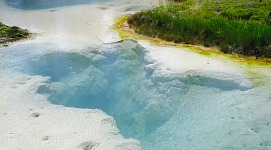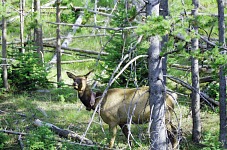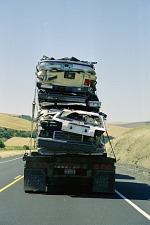Never Say Never (4/4)
Yellowstone National Parking

We hummed over the border between Grand Teton and Yellowstone National Parks. Sid headed directly toward West Thumb, a spot at Yellowstone Lake where I was to first encounter serious hot springs. The smell was incredible, but ponds with crystal clear, blue water, rimmed with white salts, invited for a bath. Alas, a few weeks after our visit, a threesome of Americans made this dream come true, ignoring all warnings that the water is about 180°F (80°C). I think that one of them, a girl, did not survive.
While parking on a huge lot, we noticed a car with North Dakota plates and a small Czech flag sticker on a trunk. And naturally — in a few minutes we got approached by two guys. They said they were studying in Dakota and went on a trip. We exchanged some polite phrases and moved on, each group at their own pace, toward the Yellowstone Lake, on a trail among geysers.
Following a true American tradition, we did not waste any time walking, got back into our car and drove on. To tell the truth — you would not get far in Yellowstone without a vehicle. The park is huge and if you, like we do, pick only the cherries on a cake... but this time we almost did not get anywhere at all, car or no car. We barely left the lake shores, and — next mile we moved in ten feet jumps, stop and go, stop and go. A congestion all the way ahead we could see. Sid croaked that if the jam goes to the next intersection (about five miles), I should start unpacking our sleeping bags.

Eventually we did not need them. All the trouble was, I kid you not, caused
by one elk grazing several yards from the road. Unfortunately, one could watch
it from the car. It looked like a royal audience; each car would stop, windows
would be rolling down, camera lenses would appear, click, click, windows up, car
drives away. Next one moves into the spot, stops, click, click (take another
picture, dear, now that we have waited for so long here
 ).
).
If that elk did not go to take a nap somewhere, they're still photographing it.
After our experience with deer on Shadow Mountain, munching grass practically
from under our pillows, after having seen a bear and moose, after having passed
six feet away from a herd of bisons, a single tired deer did not faze us. Other
park visitors behaved like a on a tropical safari.
Some distance farther, a whole herd of deer grazed on a meadow. Cars stopped chaotically in the middle of the road, tourists scrambled around in neck-breaking frenzy and ran, ran towards the animals. It looked like a chase after a UFO. Brrr. I began to feel pretty fed up with this Yellowstone. No way we would want to drag ourselves to this madhouse again.
We could not leave out Old Faithful, of course, a geyser that earned its name by its regularity with which it erupts. About an hour was left to the beginning of this spectacle, and we spent it walking around. Wooden and paved trails have been built across a large clearing around a river. Some sections stand on poles as a salty crust around the geysers is fragile and a person could break through and fall into a former or future geyser. Soon, my head was spinning — after you've seen 156th eruption... it becomes kind of tiresome.
Meanwhile, good two thousand souls gathered around the
"Old Faithful". We watched from a distance... well, another geyser...
 .
Time had come for us — to relocate.
.
Time had come for us — to relocate.
We were quietly hoping that all wildlife shows had ended, for we needed to drive through to the northern park exit. We made good progress, although driving like in a motorcade, we advanced rapidly.
Sid lured me to see one more attraction, the Yellowstone River Canyon. An overflowing parking lot and a concrete path reminding of a downtown pedestrian zone did not appeal to us, but the view was well worth our patience. The canyon is practically impossible to hike, its high slopes being cut by a really wild river, occasionally forming huge waterfalls.
We discovered that only a few steps farther, there was yet another lookout to the falls. On our way there we have noticed a sign pointing to a staircase descending into the canyon, claiming that it was "not recommended for people with heart and breathing problems" — hooray! A whole family rested at the first turn; they told us that the view from below was quite pretty, but the ascent was really tough. Our assumption got confirmed — was it necessary to make more than a hundred strides from the car? Overcome a few stairs? Yes? Such place would be devoid of crowds.
It was. And facing a huge waterfall took our breath away. Water mist hovered
up almost a hundred feet, and condensing on the canyon walls, it flowed back
into the river in a network of hundreds of tiny streams. Two new visitors with
"strong hearts" came downstairs, our private moment with a waterfall
had expired. All that we had left was a chance to check out our circulatory
system, whether it would support our upward hike (about five stories). We
survived — we must be quite healthy
 .
.
There were other Yellowstone attractions that we left behind, like Mammoth Lakes. But we felt like after a day spent in the middle of a metropolis, not like outdoors. I had a feeling that if I saw yet another eager tourist, I'd feel compelled to scream hysterically. A soothing image of unpopulated Montana outside the border of Yellowstone motivated me even more than a promise of a solid dinner.
Fast forward through Montana, Washington, Oregon ... home!

The meal was OK at a questionable pizzeria, which obviously was not a choice of tourist hordes. My nerves stopped buzzing at the sight of normal, tired, disinterested faces — the folks there certainly did not look ready to cheer over any molting squirrel. What a relief.
The lights went down outside and an unreal, orange moon illuminated our road.
We found it beautiful. Under its guidance we reached Bozeman, Montana,
where we gladly accepted the hospitality of a motel, and rushed into a shower
(a combination of sweat, sunscreen and dust mixes into a peculiar make-up
 ).
).
A maid burst into our room in the morning, obviously assuming we were long gone (I don't know why, but since then we always carefully place a DON'T DISTURB sign on the doorknob). With our breakfast, we discovered why the moon was so wonderful. Montana was on fire and that pretty red color was just a regular light filtered through smoke.
We had to drive through Montana much faster than we had planned. Sid needed to be back at work in a few days anyway, and we could not extend our trip forever, no matter how much I desired to see Glacier NP. So we continued for a whole morning under a smoky sky to Missoula. We ate our lunch there, driving to Lolo and Pomeroy. We saw several ugly forest fires in one particularly beautiful pass. They looked so harmless in southern Idaho, where only thin grass burned. Alas, wonderful deep forest was dying here here.
Our road led along a substantial section of Clearwater River. A very pretty stream, with trees and rocks and clear water, it seemed almost hokey. We were entering Washington state.
Feeling like having a dinner in Lewiston, Idaho, we found only classical entries on a menu: sandwich, beans, steak, or hamburger. I ordered a tuna sandwich — and got a toast with jelly. I must have a disturbing effect on the hearing of waitresses or something. It actually happens to me quite often, and it does not matter that I poke my finger at the spot in the menu where they show my selection, to avoid any mistakes. This server took it with humor, and brought me my tuna. A thought of bed came to our minds.
There was nothing around us, only "fuzzy" hills of yellow, dried grass. Sid maintained that there is a National Forest a little bit further south of Pomeroy, but the occurrence of trees did not seem probable to me.
Though Pomeroy is a tiny little dwelling, it took us a while to find the right turnoff. Good that we take our GPS along. Sid found us on the map and directed me to go somewhere among the hills. After a few miles... there really was a forest. Finding the right spot for camping was a matter of minutes — a grassy clearing with a few grown trees that was prone to offer a pretty view in the morning.
No deer came at night to bite pieces of us, but, for a change, coyotes howled nearby. The morning was a real jewel; one of those dawns which promised solid, sunny weather, yet a shade under the trees was pleasantly cool. Nobody in sight, only a blue jay squeaked in protest. Loafing around, we nibbled at our breakfast, chatted, and enjoyed the lack of company of others.
Sid got so much carried away by this placidity that he grabbed our gun and shot three times into a stump in front of our tent. To my worries that "somebody may come to hassle us", he said that shooting in a National Forest was not forbidden, only hunting out of season.
But to my horror, in a short while a car engine could be heard from the woods. It took John Smith about fifteen minutes to find us. Meanwhile we managed to get dressed and pack most of our stuff (including our pistol). John, a red-haired, hawk-nosed guy asked us whether we heard anything, whether we heard anybody shoot three times, for help. I don't really know why, but we kept mum about our gun then.
John Smith was employed in the forest as a fire guard, and was obviously thrilled to have somebody to talk to. We got tied up with him certainly over an hour. He told us about putting out forest fires — a truck drops a gang of men with shovels, who are only able to dig a trench that may stop an advancing fire. Since roads are rare in American forests, many places are inaccessible to any equipment.
He also said that he was one quarter Indian (did not look much like one, except for the nose), that he was staying at a motel in Pomeroy, that he was divorced and living with a girlfriend, and had a six year old son with her, and they were planning to marry ... simply an ordinary life of a guy from Washington.
We told him about our encounter with a bear and he in turn described how he
met a grizzly bear cub. John got startled, the little bear got startled. It did
not wait for anything else and began to whine. John did not wait either and ran
away towards his car. On his way he almost knocked over his brother who was
there with him, shouting to run as well. They locked themselves in the car while
a mad grizzly mother drooled all over their windows, and quickly loaded their
guns, just in case the situation got worse. The bear mother eventually got tired
and went away.
I kept asking about bears because nobody before would tell us anything about
what to do if you encounter one, except to try to avoid a bear altogether.
This is the John Smith's advice: don't carry any food in you bags, or sunscreen or any other good smelling things. If you carry such stuff, you become a living target and ought to behave like one (e.g. don't argue with a bear over "his new" bag, and don't try to talk him out of chewing on your driver license or your toothpaste). Black bears normally eat small animals, berries, and garbage out of bins on parking lots — a man is too big for them. If a bear looks like he's undecided (or quite decided, for that matter), you may try to scare it away — by shooting in the air, or banging two rocks together. Bears were for a long time hunted by man and are afraid of loud, cracking noises. You can also try to bark like a dog, but a big one, or like a pack of dogs, not like a Pekinese (John Smith, to my amusement, demonstrated both kinds of barking). If you become bear's prey, you can still try to climb a tree. A bear can naturally climb trees as well, only he's much heavier than a man and branches break under his weight. If he happens to follow you up anyway, it is recommended to kick him in his nose — the only sensitive place on a bear's body. And, of course, you can always try to run. If you must run, it is better to run downhill, the steeper, the better. At the closest chance, grab a small tree and swing around it 180°. A bear turns his paws inward when walking, and puts them one over another. If he tries to make a sharp turn, he will mix them up and tumble. A bear that rolled down the hill usually changes his mind about such difficult meal and moves away.
Then John Smith explained at length to Sid where to go if we really want to
see a grizzly. I remember that place well; Sid should not think that he will be
able to drag me there any time in the future — under any pretense. I also
remember John saying that there's nothing you can do about a grizzly, either you
should not run at all, or you ought to run away as fast as you can — it
depends on the individual bear you encounter, and on his momentary mood.

Eventually we managed to pack and leave. Our journey continued along Columbia River to Portland, Oregon. The river kept growing wider, I never saw a river so large in my life before. Geometrically cut hills and river banks gave the stream a touch of Egyptian atmosphere.
We stopped briefly to visit Multnomah Falls, stretched our legs and hiked a bit. Driving through Hillsboro, Oregon, we felt like having dinner and Sid quizzed me about the extent of my hunger and my preference of food ethnicity. I suggested Mexican, and Sid cut a corner around a block and stopped in front of something that looked like a rebuilt garage. If you want Mexican, he said, it ought to be authentic.
Everybody at the garage spoke only Spanish; of the menu (a large sign board above a counter, for this was a low end eatery) I only recognized burrito; I chose a chicken option and quietly wondered if we did not put ourselves into somewhat wild environment. A soiled linoleum on the floor, formica tables, a TV set on a rack showing some Spanish language soap opera, a couple at one of the tables were evidently Mexican, a husband who took his wife out to a dinner after a tiresome shift at a warehouse store.
A boy behind the counter almost fainted when we entered, and since the chef himself brought us our order, I reckon that we might have been the first gringos ever to enter the premises. For two tasty burritos and two sodas, we paid what we would normally pay for one tired sandwich. I did not even manage to finish mine.
Well fed, we jumped in our car again and headed for the coast, to Tilamook. If you ever feel the urge to go to Tilamook, suppress it. The coast is breathtaking, but a substandard motel costs over hundred bucks, there's no place to eat, it's a horrible dump.
We squatted on a beach in the morning for a while and then continued southwards, heading home. As the day advanced, we felt the pressure mounting up and we eventually gave up our idea of driving along the coast all the way. We went for a much faster, inland freeway, for we had completely satisfied all our travelling urges on this trip.
Hence I let go of my opinion to never want to visit America. Within
a month that followed the above events, our
wedding took place, and my moving here.
I live now in a country with oceans, deserts,
forests, mountains, volcanos, lakes, and snow; where stores are open at least
till nine p.m. (and some never close), where you submit your tax return over the
internet, where policemen cannot make random searches, and where I can leave
a door open to our balcony on a ground level, without a fear or burglary when
leaving our apartment, and most importantly — where restaurant waiters
refill your coffee at no extra charge, again and again.